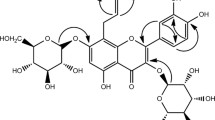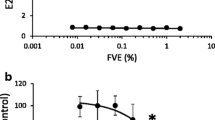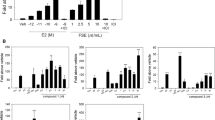Abstract
Rhizomes of Dioscorea species are traditionally used for relieving menopausal syndromes in Chinese medicine. The estrogen-stimulating bioactive principles have been demonstrated in our previous study. In this study, the estrogen-stimulating effects of proteins isolated from four Dioscorea species [D. alata L. (DA), D. zingiberensis C.H. Wright (DH), D. collettii var. hypoglauca (Palib.) S.J. Pei & C.T. Ting (DH), and D. oppositifolia L. (DO)] have been investigated and compared. Microscopic authentication of four Dioscorea species was performed by using paraffin and powder sections of the rhizomes. The potential bioactive proteins of four Dioscorea species have been rapidly isolated by using a DOI-antibody affinity column chromatography on immobilized antibodies against on estradiol-stimulating protein from DO (DOI), and their bioactivity has been rapidly confirmed and compared by phenotypic (i.e., estradiol-stimulating effect) and target-based (i.e., STAR, aromatase, estrogen receptors) screening approaches. The estrogen-stimulating activity of bioactive proteins from DO is the highest. In addition, bioactive proteins from DO upregulated the estradiol-metabolizing enzymes (aromatase and steroidogenic acute regulatory protein). Meanwhile, bioactive proteins from DA, DH and DO upregulated estrogen receptor β (ERβ). All bioactive proteins did not change the expression of estrogen receptor β (ERα). The estrogen-stimulating bioactive proteins isolated from DO increased biosynthesis of estradiol and upregulated the protein expression of aromatase, steroidogenic acute regulatory protein, and ERβ. The results scientifically support the traditional use of DO in Chinese medicine for relieving menopausal syndrome. Besides, proteins from DA and DZ could also upregulate the translational levels of ERβ, and potentially reducing the risk of ovarian cancer, which also support the clinical use of them for treating female aging disorder.

Comparative Analysis of DOI-like Proteins with Stimulating Activity on Ovarian Estradiol Biosynthesis from Four Different Dioscorea Species in vitro





Similar content being viewed by others
Abbreviations
- DA:
-
D. alata L.
- DZ:
-
D. zingiberensis C.H. Wright
- DH:
-
D. collettii var. hypoglauca (Palib.) S.J. Pei & C.T. Ting
- DO:
-
D. oppositifolia L
- E2 :
-
17β-estradiol
- CYP19:
-
aromatase
- StAR:
-
steroidogenic acute regulatory protein
- ERα:
-
estrogen receptor alpha
- ERβ:
-
estrogen receptor beta
References
Burger, H., et al. (2007). Nomenclature and endocrinology of menopause and perimenopause. Expert Review of Neurotherapeutics, 7(11 Suppl), S35–S43.
Shuster, L. T., et al. (2010). Premature menopause or early menopause: long-term health consequences. Maturitas, 65(2), 161–166.
Lacey, J. V., Jr., et al. (2002). Menopausal hormone replacement therapy and risk of ovarian cancer. JAMA, 288(3), 334–341.
Wang, S. W., et al. (2015). Network pharmacological identification of active compounds and potential actions of Erxian decoction in alleviating menopause-related symptoms. Chinese Medicine, 10, 19.
Wong, K. L., et al. (2015). A novel, stable, estradiol-stimulating, osteogenic yam protein with potential for the treatment of menopausal syndrome. Scientific Reports, 5, 10179.
Sze, S. C. W., et al. (2011). Effects of Erxian decoction, a Chinese medicinal formulation, on serum lipid profile in a rat model of menopause. Chinese Medicine, 6, 40.
Sze, S. C. W., et al. (2009). A novel mechanism: Erxian Decoction, a Chinese medicine formula, for relieving menopausal syndrome. Journal of Ethnopharmacology, 123(1), 27–33.
Shang, Y. (2006). Molecular mechanisms of oestrogen and SERMs in endometrial carcinogenesis. Nature Reviews Cancer, 6(5), 360–368.
Dubik, D., & Shiu, R. P. (1992). Mechanism of estrogen activation of c-myc oncogene expression. Oncogene, 7(8), 1587–1594.
Stettner, M., et al. (2007). The relevance of estrogen receptor-beta expression to the antiproliferative effects observed with histone deacetylase inhibitors and phytoestrogens in prostate cancer treatment. Molecular Cancer Therapeutics, 6(10), 2626–2633.
Pearce, S. T., & Jordan, V. C. (2004). The biological role of estrogen receptors alpha and beta in cancer. Critical Reviews in Oncology/Hematology, 50(1), 3–22.
Brandenberger, A. W., Tee, M. K., & Jaffe, R. B. (1998). Estrogen receptor alpha (ER-alpha) and beta (ER-beta) mRNAs in normal ovary, ovarian serous cystadenocarcinoma and ovarian cancer cell lines: down-regulation of ER-beta in neoplastic tissues. Journal of Clinical Endocrinology and Metabolism, 83(3), 1025–1028.
Simpson, E. R., et al. (1994). Aromatase cytochrome P450, the enzyme responsible for estrogen biosynthesis. Endocrine Reviews, 15(3), 342–355.
Bulun, S. E., et al. (1999). Aromatase in aging women. Seminars in Reproductive Endocrinology, 17(4), 349–358.
Gosden, R. G., & Faddy, M. J. (1994). Ovarian aging, follicular depletion, and steroidogenesis. Experimental Gerontology, 29(3–4), 265–274.
Li, W. (2006). The clinical study of treating peripheral menopause syndrome (PMS) with the Decoction of Bu-Shen-An-Geng. In Chinese gynecology. Shandong University of Traditional Chinese Medicine.
Zhou, J., Gan, B. L., Wei, G. N., Chen, J. M., & Qin, L. (2009). Experimental research of Angeng Recipe on climacteric rats. Chinese Traditional Patent Medicine, 31(9), 3.
Komesaroff, P. A., et al. (2001). Effects of wild yam extract on menopausal symptoms, lipids and sex hormones in healthy menopausal women. Climacteric, 4(2), 144–150.
Chinese Pharmacopoeia Commission. (2015). Pharmacopoeia of the People’s Republic of China (Vol. I). Beijing: People’s Medical Publishing House.
Liu, L., et al. (2010). Biotransformation of steriodal saponins in Dioscorea zingiberensis C. H. Wright to diosgenin by Trichoderma harzianum. Applied Microbiology and Biotechnology, 85(4), 933–940.
Wei, M., et al. (2016). Low pressure steam expansion pretreatment as a competitive approach to improve diosgenin yield and the production of fermentable sugar from Dioscorea zingiberensis C.H. Wright. Bioresource Technology, 206, 50–56.
Hu, K., et al. (1999). A new pregnane glycoside from Dioscorea collettii var. hypoglauca. Journal of Natural Products, 62(2), 299–301.
Cheng, W. Y., Kuo, Y. H., & Huang, C. J. (2007). Isolation and identification of novel estrogenic compounds in yam tuber (Dioscorea alata Cv. Tainung No. 2). Journal of Agricultural and Food Chemistry, 55(18), 7350–7358.
Hsu, F. L., et al. (2002). Both dioscorin, the tuber storage protein of yam (Dioscorea alata cv. Tainong No. 1), and its peptic hydrolysates exhibited angiotensin converting enzyme inhibitory activities. Journal of Agricultural and Food Chemistry, 50(21), 6109–6113.
Lin, P. L., et al. (2009). Yam storage protein dioscorins from Dioscorea alata and Dioscorea japonica exhibit distinct immunomodulatory activities in mice. Journal of Agricultural and Food Chemistry, 57(11), 4606–4613.
Ulbricht, C., et al. (2003). Wild yam (Dioscoreaceae). Journal of Herbal Pharmacotherapy, 3(4), 77–91.
Patel, K., Gadewar, M., Tahilyani, V., & Patel, D. K. (2012). A review on pharmacological and analytical aspects of diosgenin: a concise report. Natural Products and Bioprospecting, 2, 46–52.
Marker, R. E. (1940). The preparation of testosterone and related compounds from sarsasapogenin and diosgenin. Journal of the American Chemical Society, 62, 2543–2547.
Olofson, R. A., & Gortler, L. B. (1999). The “marker degradation” and creation of the Mexican steroid hormone industry 1938–1945. Washington: The American Chemical Society and the Sociedad Química de México.
Wu, W. H., et al. (2005). Estrogenic effect of yam ingestion in healthy postmenopausal women. Journal of the American College of Nutrition, 24(4), 235–243.
Sze, S. C. W, Wong, K. L., Tong, Y., Zhang, Y. B., & Cheung, H. P. (2013). Novel bioactive protein isolated from Chinese yam and uses thereof. In USPTO (Ed.), USPTO, USA. Patent Pub. No.:US20130217626A1. Pub. Date: Aug. 22, 2013.
Sze, S. C. W., Wong, K. L., Tong, Y., Zhang, Y. B., & Cheung, H. P. (2013). Novel bioactive protein isolated from Chinese yam and uses thereof. In P. C. Treaty (Ed.). Patent Pub. No.:WO/2013/023617. Pub. Date: Feb. 21, 2013.
Srivastava, V. K., et al. (2005). Effect of ethanol on follicle stimulating hormone-induced steroidogenic acute regulatory protein (StAR) in cultured rat granulosa cells. Alcohol, 37(2), 105–111.
Ruzin, S. E. (1999). Plant microtechnique and microscope. New York: Oxford University Press.
Campbell, K. L. (1979). Ovarian granulosa cells isolated with EGTA and hypertonic sucrose: cellular integrity and function. Biology of Reproduction, 21(4), 773–786.
Lovekamp-Swan, T., & Chaffin, C. L. (2005). The peroxisome proliferator-activated receptor gamma ligand troglitazone induces apoptosis and p53 in rat granulosa cells. Molecular and Cellular Endocrinology, 233(1–2), 15–24.
Laemmli, U. K. (1970). Cleavage of structural proteins during the assembly of the head of bacteriophage T4. Nature, 227(5259), 680–685.
Lou, Z. Q., & Qin, B. (1995). Species systematization and quality evaluation of commonly used Chinese traditional medicine (Vol. 2). Beijing: Beijing University Medical Press.
State of Administration of Traditional Chinese Medicine. (1999). Chinese materia medica. Shanghai: Shanghai Science and Technology Press.
Commission, C. P. (2009). An illustrated handbook on microscopic identification of Chinese crude drugs for Chinese pharmacopoeia. Beijing: People’s Medical Publishing House.
Chinese Pharmacopoeia Commission. (2010). Chinese pharmacopoeia I. Beijing: Chemical Industry Press.
The Ministry of Health Pharmacopoeia Committee. (1999). A colored atlas of microscopic identification of Chinese material medica in powdered from as specified in pharmacopoeia of the People’s Republic of China. Guangdong: Guangdong Science and Technology Press.
Hsueh, A. J., et al. (1984). Hormonal regulation of the differentiation of cultured ovarian granulosa cells. Endocrine Reviews, 5(1), 76–127.
Son, I. S., et al. (2007). Antioxidative and hypolipidemic effects of diosgenin, a steroidal saponin of yam (Dioscorea spp.), on high-cholesterol fed rats. Bioscience Biotechnology and Biochemistry, 71(12), 3063–3071.
Araghiniknam, M., et al. (1996). Antioxidant activity of dioscorea and dehydroepiandrosterone (DHEA) in older humans. Life Sciences, 59(11), PL147–PL157.
Mueller, S. O., & Korach, K. S. (2001). Estrogen receptors and endocrine diseases: lessons from estrogen receptor knockout mice. Current Opinion in Pharmacology, 1(6), 613–619.
Brekelmans, C. T. (2003). Risk factors and risk reduction of breast and ovarian cancer. Current Opinion in Obstetrics and Gynecology, 15(1), 63–68.
Gambacciani, M., et al. (2003). Hormone replacement therapy and endometrial, ovarian and colorectal cancer. Best Practice & Research Clinical Endocrinology & Metabolism, 17(1), 139–147.
Riman, T., et al. (2002). Hormone replacement therapy and the risk of invasive epithelial ovarian cancer in Swedish women. Journal of the National Cancer Institute, 94(7), 497–504.
Hillier, S. G., et al. (1998). Expression of oestrogen receptor alpha and beta in cultured human ovarian surface epithelial cells. Molecular Human Reproduction, 4(8), 811–815.
Pujol, P., et al. (1998). Differential expression of estrogen receptor-alpha and -beta messenger RNAs as a potential marker of ovarian carcinogenesis. Cancer Research, 58(23), 5367–5373.
Rutherford, T., et al. (2000). Absence of estrogen receptor-beta expression in metastatic ovarian cancer. Obstetrics and Gynecology, 96(3), 417–421.
Fujimura, M., et al. (2001). Absence of estrogen receptor-alpha expression in human ovarian clear cell adenocarcinoma compared with ovarian serous, endometrioid, and mucinous adenocarcinoma. American Journal of Surgical Pathology, 25(5), 667–672.
Talukder, M. M., & Shiong, S. C. (2015). Stabilization of chromobacterium viscosum lipase (CVL) against ultrasound inactivation by the pretreatment with polyethylene glycol (PEG). Applied Biochemistry and Biotechnology, 177(8), 1742–1752.
Wang, X., Qian, C., & Yu, X. (2014). Synthesis of nano-hydroxyapatite via microbial method and its characterization. Applied Biochemistry and Biotechnology, 173(4), 1003–1010.
Wong, K. L., et al. (2014). Bioactive proteins and peptides isolated from Chinese medicines with pharmaceutical potential. Chinese Medicine, 9, 19.
Author information
Authors and Affiliations
Corresponding author
Ethics declarations
Conflict of Interest
The authors declare that they have no conflicts of interest.
Funding
We thank the Innovation and Technology Support Programme of the government of Hong Kong Special Administrative Region for the generous support of this project (Project code: ITS/262/09FP) and Seed Funding for Basic Research of the University of Hong Kong (Project code: 201211159146; 201011159213).
Rights and permissions
About this article
Cite this article
Lu, J., Wong, R.N.S., Zhang, L. et al. Comparative Analysis of Proteins with Stimulating Activity on Ovarian Estradiol Biosynthesis from Four Different Dioscorea Species in vitro Using Both Phenotypic and Target-based Approaches: Implication for Treating Menopause. Appl Biochem Biotechnol 180, 79–93 (2016). https://doi.org/10.1007/s12010-016-2084-x
Received:
Accepted:
Published:
Issue Date:
DOI: https://doi.org/10.1007/s12010-016-2084-x




